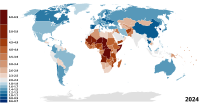
Photo from wikipedia
Abstract Fertility is a key process shaping long-term population dynamics. Distinctive fertility trends have characterized demographic transitions, exhibiting sequential periods of spatial convergence and divergence. This descriptive study investigates the… Click to show full abstract
Abstract Fertility is a key process shaping long-term population dynamics. Distinctive fertility trends have characterized demographic transitions, exhibiting sequential periods of spatial convergence and divergence. This descriptive study investigates the spatiotemporal evolution of Total Fertility Rate (TFR) and Crude Birth Rate (CBR) at different geographical scales in Italy between 2002 and 2018. Descriptive statistics of the TFR and CBR values across geographical scales were computed and the associated maps were prepared for the most detailed spatial levels available; specifically, down to the municipality level. Spatial analysis at the provincial and municipality level was based on both global and local Moran's indexes. Southern Italy, a mostly disadvantaged region, was characterized by relatively stable fertility patterns; fertility then decreased following an opposite trend with respect to economic conditions. The reverse relationship was observed in Northern Italy. As such, economic expansion and recession impacted fertility more intensively in Northern Italy.
Journal Title: Applied Geography
Year Published: 2020
Link to full text (if available)
Share on Social Media: Sign Up to like & get
recommendations!